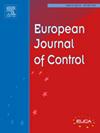Assist-as-needed control of a soft rehabilitation robot for the finger using an interaction torque observer
IF 2.6
3区 计算机科学
Q2 AUTOMATION & CONTROL SYSTEMS
引用次数: 0
Abstract
This paper introduces an Assist-as-Needed (AAN) control strategy for a soft finger rehabilitation robot using a fiber-reinforced bending (FRB) actuator. Most conventional rehabilitation controllers focus solely on position or force control and fail to incorporate the patient’s active participation during the rehabilitation process. This lack of engagement limits the effectiveness of patient-specific rehabilitation, highlighting the need for interaction-based strategies. To address this gap, we propose a novel AAN approach that combines a nonlinear disturbance observer (NDO) and a sliding mode controller (SMC), designed using the dynamic model of the FRB actuator. The NDO estimates the patient–robot interaction torque in real-time without using external sensors or modeling the patient’s finger, while the SMC ensures robust and accurate position tracking. This interaction-based assistance enables the system to dynamically adjust the level of assistance based on the patient’s voluntary efforts, while the controller simultaneously works to guide the finger movement toward the rehabilitation trajectory, promoting a more active and patient-specific rehabilitation process. Additionally, the stability of the closed-loop system is analytically proven using Lyapunov theory. The proposed method is validated both on a finger-like mechanism simulating various patient scenarios and on a wearable rehabilitation glove used by a participant. Experimental results confirm that the AAN controller achieves superior trajectory tracking and provides adaptive assistance aligned with the patient’s capability, outperforming conventional model-free controllers.
基于交互力矩观测器的手指软康复机器人辅助控制
介绍了一种基于纤维增强弯曲(FRB)驱动器的软指康复机器人的按需辅助控制策略。大多数传统的康复控制器只关注位置或力的控制,未能纳入患者在康复过程中的积极参与。这种缺乏参与限制了患者特异性康复的有效性,突出了对基于互动的策略的需求。为了解决这一差距,我们提出了一种新的AAN方法,该方法结合了非线性干扰观测器(NDO)和滑模控制器(SMC),使用FRB执行器的动态模型进行设计。NDO在不使用外部传感器或对患者手指建模的情况下实时估计患者与机器人的相互作用扭矩,而SMC则确保了鲁棒和准确的位置跟踪。这种基于交互的辅助使系统能够根据患者的自愿努力动态调整辅助水平,而控制器同时引导手指朝着康复轨迹运动,促进更积极和针对患者的康复过程。此外,利用李雅普诺夫理论分析证明了闭环系统的稳定性。所提出的方法在模拟各种患者场景的手指状机构和参与者使用的可穿戴康复手套上进行了验证。实验结果证实,AAN控制器实现了卓越的轨迹跟踪,并提供了与患者能力相匹配的自适应辅助,优于传统的无模型控制器。
本文章由计算机程序翻译,如有差异,请以英文原文为准。
求助全文
约1分钟内获得全文
求助全文
来源期刊

European Journal of Control
工程技术-自动化与控制系统
CiteScore
5.80
自引率
5.90%
发文量
131
审稿时长
1 months
期刊介绍:
The European Control Association (EUCA) has among its objectives to promote the development of the discipline. Apart from the European Control Conferences, the European Journal of Control is the Association''s main channel for the dissemination of important contributions in the field.
The aim of the Journal is to publish high quality papers on the theory and practice of control and systems engineering.
The scope of the Journal will be wide and cover all aspects of the discipline including methodologies, techniques and applications.
Research in control and systems engineering is necessary to develop new concepts and tools which enhance our understanding and improve our ability to design and implement high performance control systems. Submitted papers should stress the practical motivations and relevance of their results.
The design and implementation of a successful control system requires the use of a range of techniques:
Modelling
Robustness Analysis
Identification
Optimization
Control Law Design
Numerical analysis
Fault Detection, and so on.
 求助内容:
求助内容: 应助结果提醒方式:
应助结果提醒方式:


